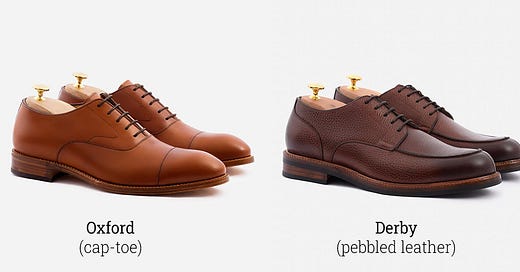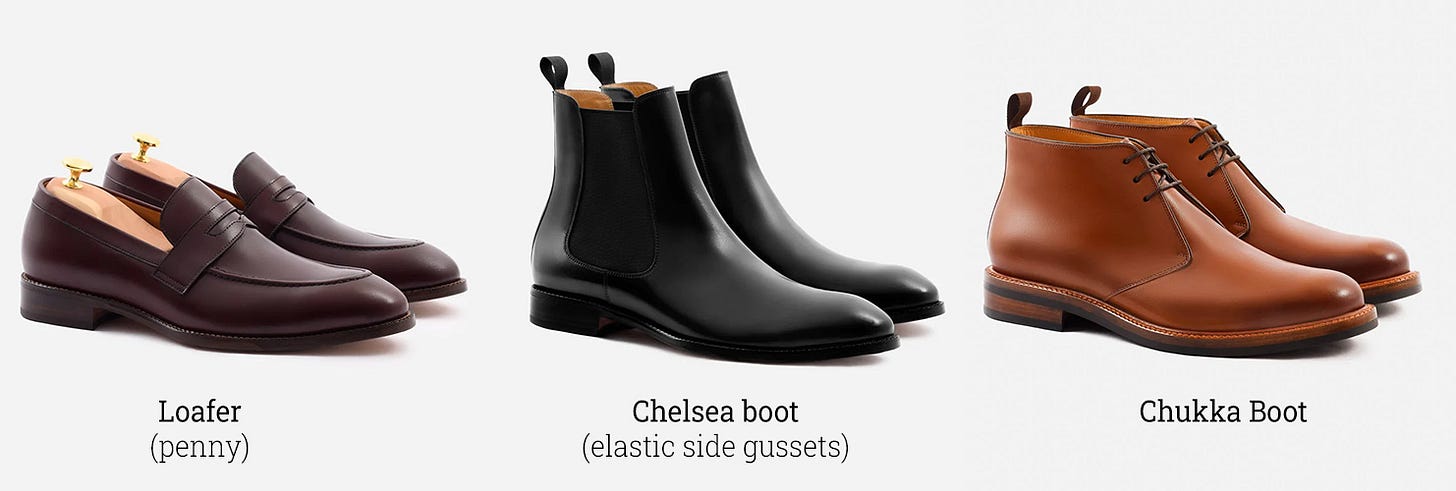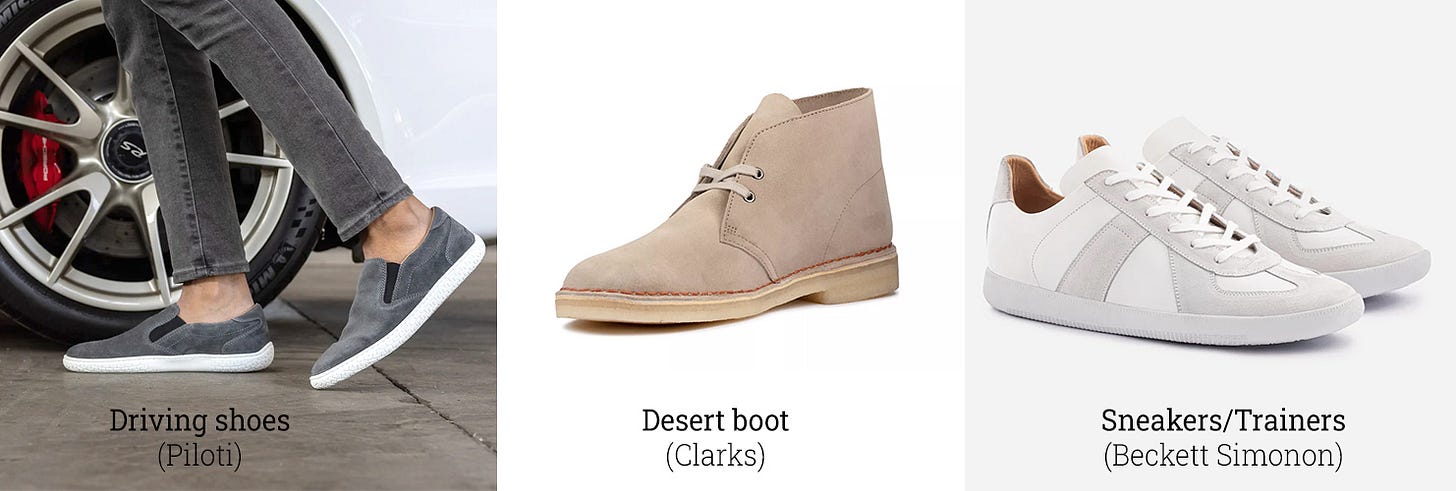Introduction To Shoes: Men's Fashion 201
Everything you need to know for footwear which gets compliments
It’s time to cover the basics of footwear. This is a massive subject and it’s impossible to cover everything all at once. For now, let’s go over the essentials for personal aesthetics. 80/20 rule as always; don’t major in the minors.
You can also read what BowTiedGerman wrote as an intro to shoes. I’m going to cover things differently here, to avoid overlap.
The Different Types of Shoes
Broadly speaking, we have 3 categories:
Formal
Semi-Formal
Casual
Formal shoes include:
Oxford
Standard formal shoe style, which every man needs. May have a cap-toe design.
Monkstrap
Fastened with 1-2 buckles instead of laces. Less formal than Oxford style yet more formal than Derby.
Derby
Least formal of the formal shoes. It has open laces (“open throat”) although not to the extent of a Chukka boot.
Brogue/Wingtip
This isn’t a type of shoe style per se - it refers to a distinctive hole pattern. Not recommended for most.
These are worn with formal or semi-formal outfits, like a suit, or something with a blazer/sport coat. They might work with smart casual or business casual. It depends. I get most of my footwear from Beckett Simonon. Good intersection of quality, aesthetics, and price. Allen Edmonds is also a good choice.
Note: suede is always more casual than polished leather.
Semi-formal (and smart/business casual tier) includes:
Loafer without decoration (Venetian style)
Most formal type of loafer.
Loafer with decoration (Bit, Penny, Tassel)
Tassels went out of style 20+ years ago, so you probably can’t pull it off.
Chelsea Boot
Ankle-height(ish) slip-on boots for autumn and winter. The most formal type of boot due to its streamlined appearance.
Chukka Boot
Ankle-height boots with short laces (2-3 eyelets) and distinctive side flaps.
Jodhpur Boot
Uncommon equestrian-inspired ankle-height boots with straps and buckles. Most people will prefer Chelsea/Chukka style.
Semi-formal footwear can go with either formal or casual outfits, depending on what you’re wearing: Lots of versatility. If you’re on a budget, and don’t have anything nice yet, I recommend two: penny loafers (spring and summer) and chelsea boots (fall and winter). They go with the greatest amount of outfits.
Casual and Smart Casual shoes include:
Driving Shoe
Casual slip-on shoe with rubber soles for better pedal grip.
Boat Shoe
Moccasin style for being on boats. Ergo, don’t buy these unless you expect to be on a boat regularly.
Desert Boot
Casual version of Chukka boots, invented by Clarks, with a crepe rubber sole (unrefined textured rubber) and suede upper.
Niche boots (Miscellaneous)
You’d choose these types of boots based on your needs. Motorcycles, hiking, construction, winter, etc. You already know what you prefer.
Espadrilles
Light canvas sandal primarily made as beach shoes. The sole is usually a fabric too, which has lower durability than rubber; these aren’t streetwear. Some styles are basically loafers, and do have rubber - although I’d prefer driving shoes at that point.
Sneakers
An average dude’s closet has nothing but sneakers. Athletic, hi-tops, trainers, etc. You can be better than average and limit the sneakers to occasional casual outfits.
Flip-Flops and Crocs
Don’t wear these in public. I know Croc fans are out there, but everything else I’ve mentioned looks 500 times better.
Most people wear sneakers as their everyday shoes. They’re everywhere and come in a wide variety. However, for casual wear, my personal favorite is Piloti driving shoes. Good quality, nice aesthetic, reasonable price, very comfortable, and not made in China.
For made in USA casual boots, I’d go with Origin Maine Bison leather. Not the most stylish, but they’re functional, and high-quality American goods are difficult to find these days. Origin also makes casual/work jeans. A few years ago, Reddit was crapping themselves over Red Wing boots for some reason. Those are probably fine too.
Shoe Accessories And Care
A shoehorn minimizes wear on the heel area, especially with leather shoes. With a tight-to-ideal fit, you 100% need a shoehorn. They’re cheap and readily available, and your shoes will last longer, so there’s no excuse to pass them up.
Cedar shoe trees also contribute to longevity. They support the structure of the shoe while you’re not wearing them, and your shoes will smell better. Cedar absorbs moisture and has a natural pleasant scent. This is why plastic shoe trees are useless - they deflect sweat and water back into your shoes until it smells worse than Shrek’s swamp.
Don’t forget shoe polish and a brush for your leather shoes. There are lots of ways to take care of your shoes as if they’re a serious investment - which they are. A well-made shoe can last basically forever with proper care. If you don’t want to hand your shoes down to your kids, NGMI.
These are all high-ROI purchases, so don’t sleep on them.
Shoe Colors and Ideal Color Pairings With Pants
For maximum aesthetic value, your socks will match your pants, and your shoes will complement both.
Black shoes go with jeans and pants that are black or gray. Most shoe colors clash with black pants, which is why black shoes are frequently recommended. Any guy with a formal black suit needs a pair. Black shoes have very limited pairings, yet are essential for the pairings where they DO work.
White shoes can go with anything. Usually lighter-colored pants. With darker-colored pants (black, dark gray, dark brown) then it depends on your outfit as a whole.
Gray shoes are fairly in-between. They can go with most outfits; it just depends on the whole outfit more than white shoes.
Blue shoes are good with basically everything except blue or black pants. Likewise, burgundy (not red) shoes work with everything except black or burgundy/red pants.
Generally speaking, you don’t want your shoes to match your pants. There should be some color/material contrast for visual interest.
The second most common recommendation, after black shoes, is brown shoes (both light and dark). Light brown is a little more versatile, good with anything in the light-to-medium pant color range. Dark brown is better with a medium-to-dark range. There’s some overlap between both browns, and they fill in each other’s weak spots. For example, dark brown shoes are fine with dark green (or olive) pants, while light brown is more questionable. Dark brown is also best with dark gray (charcoal) pants, while light brown is best for light gray pants.
Shoes come in many different colors. And you probably don’t need anything other than the above. Things like orange or purple shoes are weird, and have limited applications. Men are also famous for making the most of what they have. You don’t need 50 shoes for every occasion. Keep it simple and effective. If you have more than a dozen pairs of shoes, you better be a millionaire to justify the time and money invested.
Most versatile shoe colors to least versatile:
White
Gray
Navy
Light brown
Purple
Burgundy
Dark brown
Green
Red
Beige
Black
Orange
Conclusion
A comprehensive guide on shoes would probably sit at 20 pages. Fortunately, we don’t need that to look good. If you know what to wear, when, and with which colors, you’re 80% of the way there. That other 20%? 10% is highly technical optional information, and 10% is personal preference.
Starter wardrobe:
1 pair of dark/black formal shoes
1 pair of lighter-colored formal shoes
1 pair of dark casual shoes
1 pair of light casual shoes or white sneakers
1 pair of boots
1 pair of espadrilles or flip-flops for beach trips (optional)
Next up, we’ll begin discussing accessories like watches. Subscribe now so you don’t miss anything:
Feel free to DM me on Twitter with any questions, comments, or consulting requests.
Read the full series:
The Foundations: Men’s Fashion 101
Dress Codes and Style: Men’s Fashion 102
How To Choose Your Wardrobe Colors: Men’s Fashion 103
Introduction to Fit: Men’s Fashion 104
Introduction to Shoes: Men’s Fashion 201 ←- you are here
Introduction to Watches: Men’s Fashion 202
Introduction to Accessories: Men’s Fashion 203
Introduction to Fragrances: Men’s Fashion 204
Introduction to Hairstyles and Beards: Men’s Fashion 205






